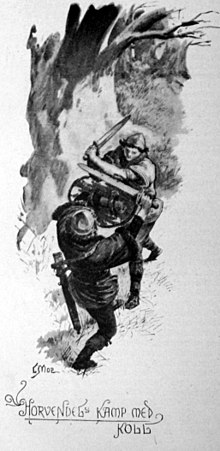Aurvandill
Aurvandill (Old Norse: [ˈɔuz̠ˌwɑndelː]) is a figure in Germanic mythology. In Norse mythology, the god Thor tosses Aurvandill's toe – which had frozen while the thunder-god was carrying him in a basket across the Élivágar rivers – into the sky to form a star called Aurvandils-tá ('Aurvandill's toe'). In wider medieval Germanic-speaking cultures, he was known as Ēarendel in Old English, Aurendil in Old High German, Auriwandalo in Lombardic, and possibly auzandil in Gothic. An Old Danish Latinized version, Horwendillus (Ørvendil), is also the name given to the father of Amlethus (Amleth) in Saxo Grammaticus' Gesta Danorum.[1][2][3] Comparative studies of the various myths where the figure is involved have led scholars to reconstruct a Common Germanic figure named *Auza-wandilaz, which seems to have personified the 'rising light' of the morning, possibly the Morning Star (Venus). However, the German and Old Danish evidence remain difficult to interpret in this model.[2][4]

Name and origin[]
Etymology[]
The Old Norse name Aurvandill stems from a Proto-Germanic form reconstructed as *Auza-wandilaz,[1] or *Auzi-Wandalaz.[5] It is cognate with Old English Ēarendel, Old High German Aurendil (≈ Orentil), and Lombardic Auriwandalo.[1][2] The Gothic word auzandil, translating the Koine Greek ἑωσφόρος (eosphoros, 'dawnbringer'), may also be related.[6]
The etymology of the name remains obscure.[1][2] The most semantically plausible explanation is to interpret Auza-wandilaz as a compound meaning 'light-beam' or 'ray of light', by deriving auza- from Proto-Germanic *auzom ('shiny, shiny liquid'; cf. ON aurr 'gold', OE ēar 'wave, sea'),[note 1] and -wandilaz from *wanđuz ('rod, cane'; cf. Goth. wandus, ON vǫndr).[8][9][10] This theory is encouraged by the Old English association of the idea of 'rising light' with Ēarendel,[8][11][12] whose name has been translated as 'radiance, morning star',[13] or as 'dawn, ray of light'.[14]
The second element has also been derived by some scholars from *wanđilaz ('Vandal'; i.e. 'the shining Vandal'),[15] from a root *wandila- ('beard'),[16] or else compared to a Norse word for sword.[17] Alternatively, the Old Norse prefix aur- has been interpreted as coming from the root *aura- ('mud, gravel, sediment; cf. ON aurr 'wet clay, mud', OE ēar 'earth'), with Aurvandill rendered as the 'gravel-beam'.[18][19]
Origin[]
Commentators since at least the time of Jacob Grimm's Deutsche Mythologie, first published in 1835, have emphasized the great age of the tradition reflected in the mythological material surrounding this name, without being able to fully reconstruct the motifs of a Common Germanic myth. The task is complicated by the fact that the stories of Orendel and Horwendillus seem unrelated to that of Ēarendel and Aurvandill. However, some scholars, including Georges Dumézil, have attempted to demonstrate that Saxo's Horwendillus and Snorri's Aurvandill are actually based on the same archetypal myth.[20]
According to scholars Rudolf Simek and John Lindow, the linguistic relation between the Germanic personal names may suggest a common myth despite the absence of Aurvandill from the Poetic Edda. They argue that Aurvendill was probably already connected with a star in the original myth, but that Snorri may have modelled the story of Aurvandils-tá ('Auvandill's Toe') on the tale of the stars emerging from Þjazi's eyes while Thor throws them into the sky.[13][14]
Prose Edda[]
The Old Norse Aurvandill is mentioned once in Norse mythology, in Skáldskaparmál, a book of Snorri Sturluson's 13th-century Prose Edda, where he is described as the husband of the witch Gróa:[21]
Thor went home to Thrúdvangar, and the hone remained sticking in his head. Then came the wise woman who was called Gróa, wife of Aurvandill the Valiant: she sang her spells over Thor until the hone was loosened. But when Thor knew that, and thought that there was hope that the hone might be removed, he desired to reward Gróa for her leech-craft and make her glad, and told her these things: that he had waded from the north over Icy Stream and had borne Aurvandill in a basket on his back from the north out of Jötunheim. And he added for a token, that one of Aurvandill's toes had stuck out of the basket, and became frozen; wherefore Thor broke it off and cast it up into the heavens, and made thereof the star called Aurvandill's Toe. Thor said that it would not be long ere Aurvandill came home: but Gróa was so rejoiced that she forgot her incantations, and the hone was not loosened, and stands yet in Thor's head. Therefore it is forbidden to cast a hone across the floor, for then the hone is stirred in Thor's head.
This passage seems to be part of a larger story where Aurvandill is abducted by the jǫtnar; the thunder-god Thor confronts one of them (Hrungnir in Snorri's version) and eventually liberates Aurvandill, but leaves the scene with the weapon of the jǫtunn stuck in his head.[22]
It is not clear exactly what celestial object is indicated in this passage. Guesses as to the identity of this star have included Sirius, the planet Venus, or the blue-white star Rigel, which could be viewed as forming the foot of the constellation Orion.[23]
Analogues[]
Gothica Bononiensia[]
The oldest attestation of this name may occur in the Gothica Bononiensia, a sermon from Ostrogothic Italy written in the Gothic language not later than the first half of the 6th century and discovered in 2009.[24] On folio 2 recto, in the context of a quotation from Isaiah 14:12, linguist P. A. Kerkhof suggested to see the word